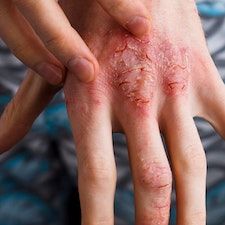Article
No Predictive Biomarkers Found to be Associated with Percent Change of Eczema Area and Severity
Author(s):
A new study explored the topic of predictive biomarkers of clinical improvement of EASI scores for atopic dermatitis patients being given dupilumab.

In a recent study, investigators were unable to identify predictive biomarkers associated with clinical improvement in Change of Eczema Area and Severity Index (EASI) for atopic dermatitis (AD) patients.
The study’s investigators noted that research into AD has shown that the condition comes from distinct cellular and molecular mechanisms, which has led to categorization of AD into endotypes.
The division of those with AD into endotype categories may be helpful for clinicians’ using therapies such as dupilumab.
This study into predictive biomarkers for AD patients was led by Takeshi Nakahara, from the Department of Dermatology at Kyushu University in Japan.
“Stratification of patients by endotype may be particularly important in the application of molecularly targeted drugs such as dupilumab,” Nakahara and colleagues wrote. “However, it remains incompletely understood which kinds of predictive biomarkers are responsible for the clinical outcome of dupilumab treatment. Against this background, we conducted a clinical study to explore the predictive biomarkers that are associated with clinical improvement in patients with moderate to severe AD treated with dupilumab.”
Background
The investigators designed a multi-center, observational, prospective study during which, from the period of October 2019 to March 2022, 110 participants (74 male, 36 female) who were 18 or older moderate-to-severe AD with EASI score of ≥16 were assessed.
In addition to having an EASI score of ≥16, the participants had to have dealt with chronic AD for a minimum of 3 years prior to the beginning of the assessment, have an Investigator's Global Assessment (IGA) score of ≥3, and have an AD body surface area of ≥ 10%.
The participants were asked to discontinue their use of cyclosporine, phototherapy, or oral steroids by a minimum of 4 weeks before treatment with dupilumab.
The study participants were given subcutaneous dupilumab therapy, with a 600 mg initial dose followed by a bi-weekly dose of 300 mg for a total of 16 weeks.
The research team took an assessment of 19 biomarkers, including the following:
- Eosinophil count
- LDH
- Total IgE
- Soluble IL-2R
- CC chemokine ligand (CCL)17/Thymus and activation-regulated chemokine (TARC)
- CCL18, CCL22, CCL26, CCL27
- IL-13, IL-22, IL-24, IL-25, IL-31, IL-33
- Thymic stromal lymphopoietin (TSLP)
- Periostin
- Squamous cell carcinoma antigen 2 (SCCA2)
- Endothelin-1 (ET-1)
Findings
The investigators were unable to find any predictive biomarkers that had an association with percent changes of EASI.
They note that these study results indicate that dupilumab has strong efficacy in EASI improvement for those given the treatment despite baseline biomarker levels.
The researchers reported that decreases in EASI score occurred from baseline up to 16 weeks (mean = 26.6, SD = 9.9), adding that pruritus-NRS, Patient-Oriented Eczema Measure (POEM), and uncomfortable skin-NRS were seen to have lowered by week 16 as well.
“The main strength of the study is the large number of participating facilities,” they wrote. “We enrolled subjects from 19 medical facilities joining a consortium throughout Japan. Furthermore, given the recent importance of PROs, it is important in real-world clinical practice to be able to find biomarkers that can predict their improvement.”
The research letter, “Exploring biomarkers to predict clinical improvement of atopic dermatitis in patients treated with dupilumab (B-PAD study),” was published online in Clinical & Experimental Allergy.




